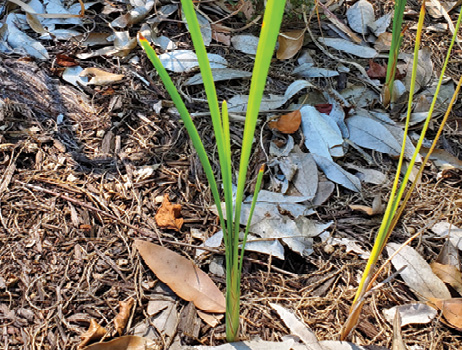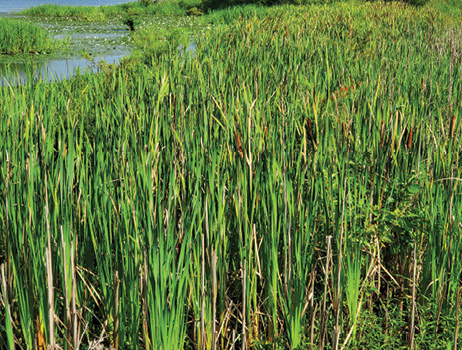Cattail | Typha spp.
Emergent | Native



Although 5–6 feet is the typical height for this well-known native species, cattails can stand up to 8 feet high. The two species in Mississippi are the common cattail, Typha latifolia, and the southern cattail, Typha domingensis.
Cattails have stout stems, broad, linear leaf blades, and the characteristic cigar-like flowering spike, which is dense and brown before erupting into a white, downy mass in the fall.
The horizontal belowground stems, or rhizomes, expand and send up new vertical growth, which allows cattails to form dense stands that creep laterally along the shallow shoreline. Although this is important habitat and a food source for wildlife, these stands can reduce shoreline access in recreational ponds.
Cattails have a long history of human use, and many parts of the plant are edible. The starchy rhizome was ground into meal by Native Americans. Young shoots can be eaten like asparagus, while the sprouts can be served in salads or boiled and served as greens. The immature flower spikes can be boiled and eaten like corn on the cob, and even the pollen has been used as a flour substitute.
Medicinally, Native Americans used the pounded roots as a dressing on wounds. Young flower heads were eaten to treat diarrhea, and the flowery down was used to dress burns. The down has also been used as padding in mattresses, pillows, and diapers. The U.S. Navy used the water-repellent seeds in life vests.
Management Value
As mentioned, cattails can be eaten, but their greatest value is for aesthetics and habitat. They are often used in water gardens and small ponds as an accent or as a privacy screen, and the flower spikes are often incorporated into dried flower arrangements.
Many species of fish and wildlife use cattail stands. Red-winged blackbirds, waterfowl, and fish will nest in the stands; beaver and muskrats eat the shoots and roots; and a variety of bird species eat the seeds.
When incorporating cattails into a natural management plan, care must be taken to prevent uncontrolled expansion. Cattails can have aggressive growth, so frequent control will be needed. Alternatively, the species can be planted in large containers and any adjacent plants removed on first appearance.
Recommended Controls
Option 1: Glyphosate (5.4-pound formulation). For each gallon of water, mix 5.0 ounces glyphosate and 1.3 ounces non-ionic surfactant. Spray to wet all leaf surfaces. Do not exceed annual herbicide rate limits as stated on the product label.
Option 2: Imazapyr (2.0-pound formulation). For each gallon of water, mix 2.6 ounces imazapyr and 1.3 ounces non-ionic surfactant. Spray to wet all leaf surfaces. Do not exceed annual herbicide rate limits as stated on the product label.
Option 3: Imazamox (1.0-pound formulation). For each gallon of water, mix 1.5 ounces of imazamox and 1.3 ounces non-ionic surfactant. Spray to wet all leaf surfaces. Do not exceed annual herbicide rate limits as stated on the product label.
For these herbicides, multiple applications may be needed to achieve eradication. The best approach is to treat with herbicides when plants are actively growing.
Read and follow all chemical label instructions, especially the section on the use of personal protection equipment.

The information given here is for educational purposes only. References to commercial products, trade names, or suppliers are made with the understanding that no endorsement is implied and that no discrimination against other products or suppliers is intended.
Publication 3735-21 (POD-11-23)
By Wes Neal, PhD, Extension/Research Professor, Wildlife, Fisheries, and Aquaculture; Dennis Riecke, Fisheries Coordinator, Mississippi Department of Wildlife, Fisheries, and Parks; and Gray Turnage, PhD, Assistant Research/Extension Professor, GeoSystems Research Institute.
The Mississippi State University Extension Service is working to ensure all web content is accessible to all users. If you need assistance accessing any of our content, please email the webteam or call 662-325-2262.



